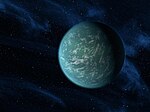astro.wikisort.org - Meteorite
PSR J1719−1438 b is an extrasolar planet that was discovered on August 25, 2011, in orbit around PSR J1719−1438, a millisecond pulsar. The pulsar planet is most likely composed largely of crystalline carbon but with a density far greater than diamond.[1][2] PSR J1719-1438 b orbits so closely to its host star that its orbit would fit inside the Sun. The existence of such carbon planets had been theoretically postulated.
 PSR J1719-14 b | |
| Discovery | |
|---|---|
| Discovered by | Matthew Bailes et al. |
| Discovery site | Melbourne, Australia |
| Discovery date | August 25, 2011 |
Detection method | Pulsar timing |
| Orbital characteristics | |
Semi-major axis | 0.004 AU (600,000 km) |
| Eccentricity | < 0.06 |
Orbital period (sidereal) | 0.090706293 d 2.176951032 h |
Time of periastron | 2,455,235.51652439 |
| Star | PSR J1719−1438 |
| Physical characteristics | |
Mean radius | ≤0.4 RJ ≤4 REarth |
| Mass | ~1.02 MJ (~330 MEarth) |
Mean density | ≥23 g cm−3 |
Observational history
PSR J1719−1438 was first observed in 2009 by a team headed by Matthew Bailes of Swinburne University of Technology in Melbourne, Australia. The orbiting planet was published in the journal Science on August 25, 2011.[3] The planet was confirmed through pulsar timing, in which small modulations detected in the highly regular pulsar signature are measured and extrapolated.[4] Observatories in Britain, Hawaii, and Australia were used to confirm these observations.[1]
Host star
PSR J1719−1438 is a pulsar some 4,000 light-years (1,200 parsecs) away from Earth in the Serpens Cauda constellation, approximately one minute from the border with Ophiuchus. The pulsar completes more than 10,000 rotations a minute. It is approximately 12 miles (19 kilometers) across but with 1.4 solar masses.[3]
Characteristics
PSR J1719−1438 b was, at the time of its August 25, 2011, discovery, the densest planet ever discovered, at nearly 20 times the density of Jupiter (about 23 times the density of water).[1] It is slightly more massive than Jupiter.[1] It is thought to be composed of oxygen and carbon (as opposed to hydrogen and helium, the main components of gas giants like Jupiter and Saturn).
The oxygen is most likely on the surface of the planet, with increasingly higher quantities of carbon deeper inside the planet. The intense pressure acting upon the planet suggests that the carbon is crystallized, much like diamond is.[1]
PSR J1719−1438 b orbits its host star with a period of 2.17 hours and at a distance of 0.89 solar radius (619,173 km or 384,736 mi).[1]
Formation
It is highly unlikely that this planet would have formed before its parent pulsar, as the resulting supernova would destroy any nearby planets. It has been proposed that PSR J1719−1438 b is not a planet but a star. Specifically, PSR J1719−1438 b was a yellow dwarf star similar to our Sun in a binary with PSR J1719−1438, a higher-mass star. PSR J1719−1438 swelled up to become a red supergiant, but the yellow dwarf star survived the supernova. Billions of years later, PSR J1719−1438 b became a red giant and then a white dwarf.[5] The gravity from the pulsar stole hydrogen and helium, and the remaining carbon crystallized, forming the diamond planet.
See also
- WASP-12b, a carbon planet
- BPM 37093, a carbon star
- EF Eridani, a star system with a compact star and a degraded planetary-mass former star
References
- Hirschler, Ben (August 25, 2011). "Astronomers discover planet made of diamond". Reuters. Retrieved August 25, 2011.
- Bailes, M.; Bates, S. D.; et al. (August 25, 2011). "Transformation of a Star into a Planet in a Millisecond Pulsar Binary". Science. 333 (6050): 1717–1720. arXiv:1108.5201. Bibcode:2011Sci...333.1717B. doi:10.1126/science.1208890. PMID 21868629. S2CID 206535504.
{{cite journal}}: CS1 maint: url-status (link) - Tillman, Nola Taylor (August 25, 2011). "Surprise! Alien Planet Made of Diamond Discovered". Space.com. Retrieved August 25, 2011.
{{cite news}}: CS1 maint: url-status (link) - PCMag Staff (August 25, 2011). "Scientists Discover 'Diamond Planet' Orbiting Pulsar". PCMag. Retrieved August 25, 2011.
- Bailes, Matthew (August 30, 2011). "The diamond planet". mpg.de. Max-Planck-Gesellschaft. Retrieved May 23, 2022.
{{cite web}}: CS1 maint: url-status (link)
Further reading
- Bailes, M.; Bates, S. D.; Bhalerao, V.; Bhat, N. D. R.; Burgay, M.; Burke-Spolaor, S.; d'Amico, N.; Johnston, S.; Keith, M. J.; et al. (2011). "Transformation of a Star into a Planet in a Millisecond Pulsar Binary" (PDF). Science. 333 (6050): 1717–20. arXiv:1108.5201. Bibcode:2011Sci...333.1717B. doi:10.1126/science.1208890. PMID 21868629. S2CID 206535504.
- "A Planet made of Diamond" (Press release). Max Planck Institute for Radio Astronomy. August 25, 2011. Archived from the original on September 14, 2011. Retrieved August 26, 2011.
- Correa, Alfredo A.; Bonev, Stanimir A.; Galli, Giulia (2006). "Carbon under extreme conditions: Phase boundaries and electronic properties from first-principles theory". Proceedings of the National Academy of Sciences. 103 (5): 1204–8. Bibcode:2006PNAS..103.1204C. doi:10.1073/pnas.0510489103. PMC 1345714. PMID 16432191.
На других языках
[de] PSR J1719-1438b
PSR J1719-1438b ist ein extrasolarer Planet, der am 25. August 2011 in einer extrem engen Umlaufbahn um PSR J1719-1438, einen Millisekunden-Pulsar, entdeckt wurde.[1]- [en] PSR J1719−1438 b
[es] PSR 1719-14 b
PSR J1719-1438 b es un exoplaneta que orbita el pulsar PSR J1719-1438, ubicada a unos 3913.9 años luz (1200.0 pc) en la constelación de Serpens.[ru] PSR J1719−1438 b
PSR J1719−1438 b — экзопланета (пульсарная планета, сверхземля, углеродная планета) у миллисекундного пульсара. Единственный известный объект в системе PSR J1719−1438, удалённой от Земли на 3900 световых лет в направлении созвездия Змеи. Экзопланета, вероятно, состоит преимущественно из кристаллического углерода[1][2][3][4]. Большая полуось PSR J1719−1438 b всего 0,004 а. е. Это значит, что экзопланета обращается на расстоянии в 95 раз меньше расстояния от Солнца до Меркурия[4]. Существуют всего две известные планетные системы, которые находятся ещё ближе к родительскому останку звезды — это WD 0137-349 (0,003 а. е.) и WD 1202—024 (0,0021 а. е.).Другой контент может иметь иную лицензию. Перед использованием материалов сайта WikiSort.org внимательно изучите правила лицензирования конкретных элементов наполнения сайта.
WikiSort.org - проект по пересортировке и дополнению контента Википедии


